Biol 240 test 3 quiz questions
1/125
Earn XP
Description and Tags
Name | Mastery | Learn | Test | Matching | Spaced |
|---|
No study sessions yet.
126 Terms
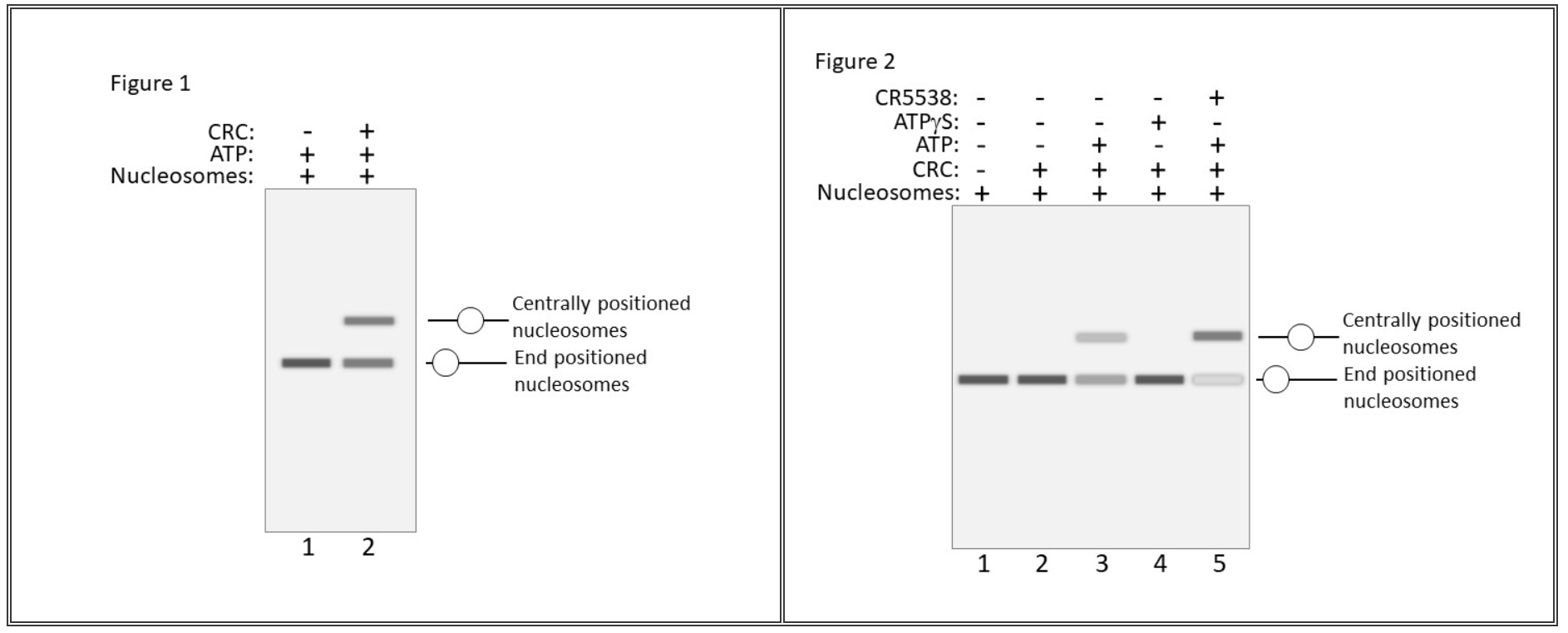
The following GIF demonstrates how chromatin-remodeling complexes can slide nucleosomes along the DNA. The motor subunit (purple) uses the energy of ATP to slide the nucleosome down the DNA. The chromosome (red) contains a short region marked in blue that can be seen changing location in relation to the nucleosome (yellow) as the chromatin-remodeling complex functions. Nucleosome sliding plays important roles in regulating chromatin packing and consequently gene expression. It also plays a role in providing access to the DNA for other proteins like DNA repair enzymes.
The nucleosome sliding activity of chromatin-remodeling complexes (CRC) can be studied in an in vitro electrophoretic mobility shift assay (EMSA) containing a DNA template, histones, chromatin-remodeling complexes, and ATP. When the nucleosomes are preloaded at the end of the DNA template and run on a polyacrylamide gel, they move through the gel. Added chromatin-remodeling complexes (CRC) can move the nucleosome to the middle of the DNA template. This slows down the electrophoretic mobility of the nucleosome and DNA through the gel allowing the researchers to measure chromatin-remodeling complex activity (Figure 1). DNA containing nucleosomes were treated with different conditions to study the requirements for nucleosome sliding (Figure 2). Conditions included the presence of ATP or the nonhydrolyzable ATPγS, and with and without a fictional drug CR5538 that can alter chromatin-remodeling complex (CRC) motor subunit function. Given the results shown in Figure 2, which of the following conclusions about the assay and chromatin-remodeling complex function are true?
Choose one or more:
A. Binding of ATP activates nucleosome sliding by the chromatin-remodeling complex (CRC).
B. Chromatin-remodeling complexes (CRC) are required for nucleosome formation.
C. The chromatin-remodeling complex (CRC) moves the nucleosomes to the center of the DNA when ATP is added.
D. The added CR5538 drug activates the chromatin-remodeling complex (CRC) motor subunit.
C. The chromatin-remodeling complex (CRC) moves the nucleosomes to the center of the DNA when ATP is added.
D. The added CR5538 drug activates the chromatin-remodeling complex (CRC) motor subunit.
Prokaryotes have chromosomes that are circular in structure. Which of the following would such chromosomes lack?
Choose one:
A. replication origin
B. complementary base pairs
C. telomeres
D. sugar–phosphate backbone
E. DNA double helix
C. telomeres
Determine whether the following statement is true or false: Human females have 23 different chromosomes, whereas human males have 24.
False
Determine whether the following statement is true or false: Histones are an example of a sequence-specific DNA binding protein.
False
What histone protein is thought to act as a linker that pulls nucleosomes together into a regular repeating array, resulting in a 30-nm fiber?
Choose one:
A. H2B
B. H3
C. H2A
D. H4
E. H1
E. H1
In the living cell, histone proteins pack DNA into a repeating array of DNA–protein particles called what?
Choose one:
nucleosomes
heterochromatin
beads on a string
octamers
euchromatin
nucleosomes
Which of the following statements about nucleosomes is false?
Choose one:
A. Nucleosomes convert a DNA molecule into a chromatin thread about one-third the length of the initial DNA.
B. Nucleosomes are found only in mitotic chromosomes.
C. Nucleosomes can be seen in the electron microscope.
D. A nucleosome consists of DNA wrapped around eight histone proteins, plus a short segment of linker DNA.
E. Nucleosomes represent the first and most fundamental level of chromatin packing.
B. Nucleosomes are found only in mitotic chromosomes.
What structure in an interphase eukaryotic cell is the site of ribosomal RNA transcription?
Choose one:
A. nucleolus
B. nucleosome
C. ribosome
D. nuclear lamina
A. nucleolus
Identify which statement(s) is/are true regarding telomere characteristics.
Choose one:
A. Telomeres allow duplicated chromosomes to become separated into daughter cells during M phase.
B. Telomeres are found in all living cells.
C. Telomeres cap the ends of linear chromosomes and prevent them from being recognized by the cell as broken DNA in need of repair.
D. Telomeres contain repeated nucleotide sequences that are required to replicate the ends of linear chromosomes.
E. All of the above are true regarding telomere characteristics.
F. Only statements B and D are true regarding telomere characteristics.
G. Only statements C and D are true regarding telomere characteristics.
G. Only statements C and D are true regarding telomere characteristics.
What are the specialized DNA sequences that are at the ends of most eukaryotic chromosomes called?
Choose one:
A. nucleosomes
B. telomeres
C. centromeres
D. centrosomes
E. histones
B. telomeres
Determine whether the following statement is true or false: In the chromatin of interphase chromosomes, regions of the chromosome that contain genes being expressed are generally more compact, while those that contain non-expressed genes are generally more extended.
false
What is the general name given to the most highly condensed form of chromatin?
Choose one:
A. X chromatin
B. nucleosome
C. euchromatin
D. heterochromatin
E. 30-nm chromatin fiber
D. heterochromatin
Determine whether the following statement is true or false: When a cell divides, its chromatin structure is completely reset.
false
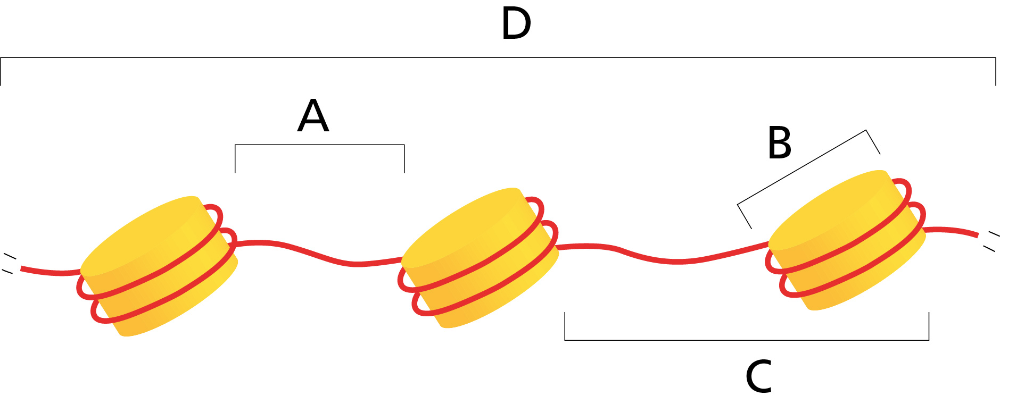
Which of the labels in the following figure shows a nucleosome core particle?
Choose one:
B
C
D
A
B
Heterochromatin can spread along a chromosome until it encounters a:
Choose one:
barrier DNA sequence.
histone modifying enzyme.
unmodified histone tail.
heterochromatin-specific protein.
barrier DNA sequence.
Where is heterochromatin not commonly located?
Choose one:
A. telomeres
B. centromeres
C. silenced X chromosomes
D. gene-poor regions of chromosomes
E. chromosomal regions carrying genes that encode ribosomal proteins
E. chromosomal regions carrying genes that encode ribosomal proteins
How do chromatin-remodeling complexes work?
Choose one:
A. They remove acetyl groups from the tails of histones, rendering the DNA more accessible to other proteins.
B. They use the energy from ATP hydrolysis to alter the arrangement of nucleosomes, rendering certain regions of the DNA more accessible to other proteins.
C. They use the energy from GTP hydrolysis to alter the arrangement of nucleosomes, rendering certain regions of the DNA more accessible to other proteins.
D. They add methyl groups to the tails of histones in order to attract other proteins.
E. They bind to nucleosomes in the 30-nm fiber and induce another level of packing, obscuring DNA from binding by other proteins.
B. They use the energy from ATP hydrolysis to alter the arrangement of nucleosomes, rendering certain regions of the DNA more accessible to other proteins.
What does each eukaryotic chromosome contain?
Choose one:
one long DNA strand
one long sequence of amino acids
one single long gene
one long double-stranded DNA molecule
one long ribonucleotide sequence
one long double-stranded DNA molecule
What evidence suggests that the large amount of excess “junk” DNA in a genome may serve an important function?
Choose one:
A. The sheer quantity of “junk” DNA suggests it must have some function in the life of the organism.
B. A portion of “junk” DNA is highly conserved in its DNA sequence among many different eukaryotic species.
C. All organisms have excess “junk” DNA.
D. Deletions or mutations that fall within “junk” DNA tend to always be harmful to the organism.
E. The nucleotide sequence of “junk” DNA is very similar to that of genes involved in important cell functions.
B. A portion of “junk” DNA is highly conserved in its DNA sequence among many different eukaryotic species.
Which of the following represents the specialized DNA sequence that attaches to microtubules and allows duplicated eukaryotic chromosomes to be separated during M phase?
Choose one:
centromere
nucleosome
mitotic spindle
centrosome
histone
telomere
centromere
Why does nitric oxide (NO) act as a paracrine signal that affects only neighboring cells?
Choose one:
A. It is rapidly washed away by the bloodstream.
B. Cell-surface NO receptors are expressed only on cells in close proximity to NO signaling cells.
C. It is rapidly converted to nitrates and nitrites in the extracellular fluid.
D. It is rapidly converted to nitrates and nitrites in the target cell.
E. It diffuses rapidly into the atmosphere.
C
Why does nitric oxide (NO) cause blood vessels to dilate?
Choose one:
A. It causes smooth muscle cells in the walls of blood vessels to relax.
B. It inhibits cyclic GMP production by inhibiting guanylyl cyclase.
C. It causes endothelial cells lining blood vessels to contract.
D. It causes smooth muscle cells in the walls of blood vessels to contract.
E. It causes endothelial cells lining blood vessels to relax.
A
Which statement regarding G proteins is true?
Choose one:
A. When a G protein is inactive, GDP is bound to its α subunit.
B. The GTPase activity resides in the β subunit.
C. The GTPase activity resides in the βγ complex.
D. The β subunit is tethered to the membrane by a short lipid tail.
E. Only the α subunit interacts with target proteins.
A
Signaling via a GPCR ceases when which condition occurs?
Choose one:
A. The α subunit dissociates from the βγ complex.
B. The G protein associates with an activated GPCR.
C. The G protein dissociates from the activated GPCR.
D. The α subunit exchanges GDP for GTP.
E. The α subunit hydrolyzes its bound GTP.
E
Which serve as direct targets for G proteins?
Choose one or more:
A. ion channels
B. ion-channel-coupled receptors
C. genes
D. membrane-bound enzymes
E. enzyme-coupled receptors
A and D
Which response to GPCR stimulation would be most rapid?
Choose one:
A. activation of a G protein that activates phospholipase C
B. activation of a G protein that inhibits adenylyl cyclase
C. activation of a G protein that regulates the opening of an ion channel
D. change in the activation of a set of target genes
E. activation of a G protein that activates adenylyl cyclase
C
When activated phospholipase C cleaves an inositol phospholipid, what happens to the small signaling molecules the enzyme produces?
Choose one:
A. Both inositol 1,4,5-trisphosphate (IP3) and diacylglycerol are retained in the membrane.
B. Inositol 1,4,5-trisphosphate (IP3) is released into the cytosol, while diacylglycerol is retained in the membrane.
C. Both inositol 1,4,5-trisphosphate (IP3) and Ca2+ are released into the cytosol.
D. Both inositol 1,4,5-trisphosphate (IP3) and diacylglycerol are released into the cytosol.
E. Inositol 1,4,5-trisphosphate (IP3) remains in the membrane, while diacylglycerol is released into the cytosol.
B
How does IP3 function in the inositol phospholipid pathway?
Choose one:
A. It generates a hole in the endoplasmic reticulum (ER), through which Ca2+ can enter the cytosol.
B. It directly activates protein kinase C (PKC).
C. It directly activates phospholipase C (PLC).
D. It opens Ca2+ channels that are embedded in the ER membrane, allowing Ca2+ to enter the cytosol.
E. It produces diacylglycerol.
D
Which of the following is not a small intracellular signaling molecule?
Choose one:
A. phospholipase C
B. cyclic AMP
C. diacylglycerol
D. Ca2+
E. inositol 1,4,5-trisphosphate
A
When activated by a GPCR, what does adenylyl cyclase do?
Choose one:
A. binds to protein kinase A
B. converts cAMP to AMP
C. inhibits cyclic AMP phosphodiesterase
D. converts AMP to cAMP
E. converts ATP to cAMP
E
The enzyme cyclic AMP phosphodiesterase helps terminate a response mediated by an increase in cyclic AMP by doing what?
Choose one:
A. converting cyclic AMP to AMP
B. converting ATP to cyclic AMP
C. inactivating adenylyl cyclase
D. activating an inhibitory G protein, Gi
E. converting cyclic AMP to ATP
A
Ca2+ is an intracellular messenger involved in which of these processes?
Choose one or more:
A. nerve cell depolarization
B. release of neurotransmitters
C. initiation of muscle contraction
D. secretion of hormones
E. triggering of embryonic development after fertilization
B and C and D and E
The concentration of free Ca2+ in the cytosol of an unstimulated cell is kept low compared with its concentration in both the extracellular fluid and the endoplasmic reticulum. Which of the following help to maintain this difference?
Choose one or more:
A. Ca2+ channels in the plasma membrane
B. Ca2+ pumps in the ER membrane
C. Ca2+ channels in the ER membrane
D. Ca2+ pumps in the plasma membrane
B and D
When activated by the binding of Ca2+, calmodulin relays the Ca2+ signal onward by doing what action?
Choose one:
A. binding to various extracellular proteins and directly activating them
B. binding to cyclic AMP
C. transferring its bound Ca2+ to various intracellular proteins, thereby activating them
D.binding to Ca2+/calmodulin-dependent protein kinases
E. destroying its bound Ca2+
D
In photoreceptor cells in the retina, light is sensed by a GPCR called rhodopsin. Which of the following represents the events that take place after the activation of rhodopsin?
Choose one:
A. activation of G protein, activation of phosphodiesterase, breakdown of cyclic GMP, opening of ion channels, change in membrane potential
B.activation of G protein, activation of phosphodiesterase, production of cyclic GMP, opening of ion channels, change in membrane potential
C. activation of G protein, activation of phosphodiesterase, breakdown of cyclic GMP, closing of ion channels, change in membrane potential
D.inactivation of G protein, inactivation of phosphodiesterase, production of cyclic GMP, closing of ion channels, change in membrane potential
E.activation of G protein, activation of guanylyl cyclase, production of cyclic GMP, opening of ion channels, change in membrane potential
C
Which statement about signaling through GPCRs is correct?
Choose one:
A.Signaling cascades associated with GPCRs always operate at the same speed, regardless of the initiating signal.
B.The cyclic AMP pathway can activate gene transcription, whereas the inositol phospholipid pathway cannot.
C.The signal molecules that bind to GPCRs all have a similar structure.
D.All second messenger molecules diffuse rapidly through the cytosol, thereby amplifying and spreading the signal.
E.Some G proteins inhibit the production of cyclic AMP.
E
Cholera and whooping cough are caused by bacterial toxins that do which of the following?
Choose one:
A.activate adenylyl cyclase
B.disable a G protein
C.activate a G protein
D.promote GTP hydrolysis
E.alter the activity of ion-gated channels
A
GPCRs are sometimes referred to as "seven-pass transmembrane receptors" for which reason?
Choose one:
A.There are seven different G proteins with which they interact to amplify signals.
B.They bind to seven extracellular signal molecules before passing a message to the cell interior.
C.Their polypeptide chain crosses the lipid bilayer seven times.
D.They form seven pores through which signal molecules can cross the lipid bilayer.
E.They are composed of seven distinct subunits arranged in a ring.
C
Following the binding of an extracellular signal molecule, receptor tyrosine kinases (RTKs) do which of the following?
Choose one:
A.rearrange their multiple membrane-spanning helices in a way that enables self-phosphorylation
B.form dimers in which each polypeptide chain phosphorylates its own cytoplasmic tail
C.become internalized so that they can phosphorylate and activate various intracellular signaling proteins
D.form dimers in which each polypeptide chain cross-phosphorylates the cytoplasmic tail of its partner.
E.activate (or inactivate) the α and βγ subunits of G proteins
D
What do the phosphorylated tyrosines on activated RTKs do?
Choose one:
A.They serve as binding sites for a variety of intracellular signaling proteins.
B.They serve as binding sites for G proteins.
C.They help the receptor dimerize.
D.They activate the enzymatic activity of the RTKs.
E.They promote receptor internalization.
A
Which of the following are activated by many receptor tyrosine kinases (RTKs)?
Choose one or more:
A.phospholipase C
B.the monomeric GTP-binding protein Ras
C.trimeric GTP-binding proteins
D.the MAP-kinase signaling module
E.phosphoinositide 3-kinase
A and B and D and E
Ras is activated by a Ras-activating protein that does what?
Choose one:
A.dephosphorylates Ras
B.causes Ras to interact with a phosphorylated RTK
C.phosphorylates Ras
D.causes Ras to hydrolyze its bound GTP
E.causes Ras to exchange GDP for GTP
E
Certain mutant Ras proteins cannot hydrolyze their bound GTP to GDP, and therefore cannot do which of the following?
Choose one:
A.be degraded
B.turn themselves off
C.activate MAP kinase directly
D.turn themselves on
E.promote cell proliferation
B
Which of the following would be a plausible strategy for reducing the activity of the Ras protein?
Choose one:
A.introducing a mutation that reduces the protein’s affinity for GDP
B.introducing a mutation that enhances the protein’s affinity for GDP
C.introducing a mutation that inactivates the protein’s GTPase activity
D.inhibiting the GTPase-activating protein (GAP) that promotes GTP hydrolysis
E.introducing a non-hydrolyzable form of GTP
B
RTKs can activate the enzyme phosphoinositide 3-kinase, which phosphorylates inositol phospholipids. These phospholipids then do what?
Choose one:
A.activate Ca2+ channels in the plasma membrane, promoting an influx of Ca2+ into the cytosol
B.activate G proteins
C.serve as phosphate donors in phosphorylation reactions
D.serve as docking sites that recruit specific intracellular signaling proteins to the plasma membrane
E.activate Ras
D
The binding of a growth factor to an RTK activates the PI 3-kinase–Akt signaling pathway, which promotes both cell survival and cell growth. How does Akt stimulate cell growth?
Choose one:
A.by activating Bad, which inactivates Bcl2
B.by inactivating Tor
C.by activating Tor
D.by inactivating Bad, which activates Bcl2
E.by phosphorylating rapamycin
C
PI 3-kinase acts by phosphorylating what molecule(s)?
Choose one:
A.inositol phospholipids
B.tyrosines on protein kinases that phosphorylate Akt
C.serines or threonines on protein kinases that phosphorylate Akt
D.serines or threonines of Akt
E.tyrosines of Akt
A
Which is true of signal integration?
Choose one:
A.It might involve a kinase in one signaling pathway inactivating a kinase in another pathway.
B.It relies on positive and negative feedback amplifying and dampening a signal.
C.It requires the generation of small intracellular messenger molecules.
D.It takes place when a single, activated target protein delivers a signal to many downstream effectors.
E.It can only take place between receptors of the same class.
A
Ras can exist in two different conformations or states, inactive and active. Which of the following correctly describe(s) the stably active state of Ras?
Choose one or more:
A. Switch 1 and switch 2 regions are in an active conformation.
B. Ras is bound to GTP.
C. Ras is bound to GDP.
D. Ras is bound to Ras-GAP.
A and B
Specific amino acids, including Arg 789 in Ras-GAP and amino acids Gln 61 and Thr 35 in Ras, all play an important role in Ras function. Why are these amino acids important?
Choose one:
A. They help Ras bind GTP tightly.
B. They help downstream signaling by binding to additional signaling proteins.
C. They help facilitate GTP hydrolysis by Ras.
D. They help Ras bind GDP tightly.
C
Which is true of the Notch signaling pathway?
Choose one:
A.Notch is an intracellular receptor that travels to the nucleus where it regulates gene transcription.
B.The Notch receptor is located in the nuclear membrane.
C.The Notch receptor activates gene expression by triggering the production of cyclic AMP.
D.The tail of the cell-surface receptor travels to the nucleus where it regulates gene transcription.
E.The Notch receptor is activated by cyclic AMP.
D
Investigators studying a particular cell response are curious about what type of cell-surface receptor might trigger it. They incubate cells with EDTA, a chemical known to sequester Ca2+.
This treatment, they find, abolishes the response they are studying. Based on this information, which type of receptor is likely to be involved?
Choose one:
A.enzyme-coupled receptors
B.G-protein-coupled receptors
C.The results are not sufficient to draw any conclusions.
D.ion-channel-coupled receptors
C
How do different steroids trigger the transcription of different sets of target genes?
Choose one:
A.Each hormone binds to a different nuclear receptor, and each receptor acts at a different set of regulatory sites in DNA.
B.Each hormone binds to a different nuclear receptor, and each receptor activates a different G protein.
C.Each hormone enters the cell through a different channel protein.
D.Each hormone binds to a different nuclear receptor, which triggers the production of a different second messenger.
E.Each hormone binds to a different cell-surface receptor, and each receptor acts at a different set of regulatory sites in DNA.
A
Which of these represents a mechanism used to terminate a signal transmitted by activated RTKs?
Choose one:
A.The RTK is inactivated by phospholipase C.
B.Tyrosine kinases remove the phosphates from RTKs and other intracellular signaling proteins.
C.The RTKs are internalized and digested in lysosomes.
D.SH2 domains remove the phosphates from RTKs and other intracellular signaling proteins.
E.SH2 domains are internalized and digested in lysosomes.
C
How does the binding of a signal molecule activate an RTK for downstream signaling?
Choose one:
A. The RTK undergoes a cleavage event to release the cytosolic portion.
B. The RTK forms a dimer and cross-phosphorylates itself.
C. The RTK changes conformation to stimulate a G-protein.
D. The RTK is an ion channel that opens in response to ligand binding.
B
If Ras contains a mutation that leads to a defect in GTP hydrolysis, this could fuel uncontrolled proliferation in cancer because
Choose one:
A.Ras is able to signal to downstream pathways inappropriately.
B.Ras is able to migrate to the nucleus and deactivate transcription of proliferation genes.
C.Ras is unable to bind to the GEF for activation.
D.Ras is unable to send signals to downstream pathways.
A
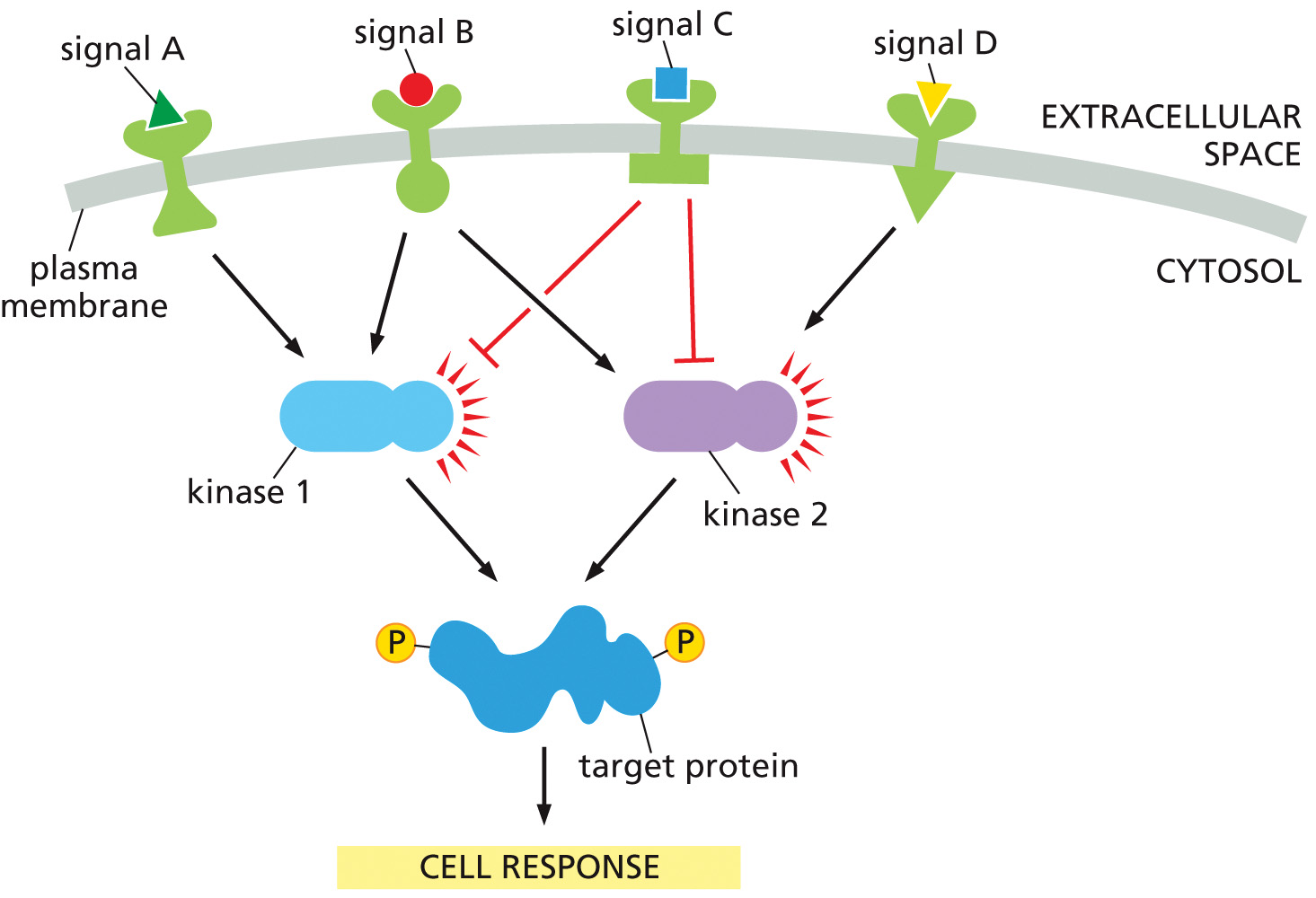
Shown is a diagram of how theoretical intracellular signaling pathways could integrate incoming signals to produce a coordinated cell response.
Which signal(s) would lead to activation of both kinase 1 and kinase 2?
Choose one:
A.signal C
B.signals A and D
C.signals A and C
D.signals C and D
B
Steroid hormones trigger transcription of target genes by
Choose one:
A.binding directly to DNA and stimulating transcription.
B.activating a kinase cascade that results in the activation of a transcription factor for a set of genes.
C.activating the release of Ca+2 ions that bind to and activate transcription factors.
D.binding to nuclear receptors that act as transcription factors for specific genes.
D
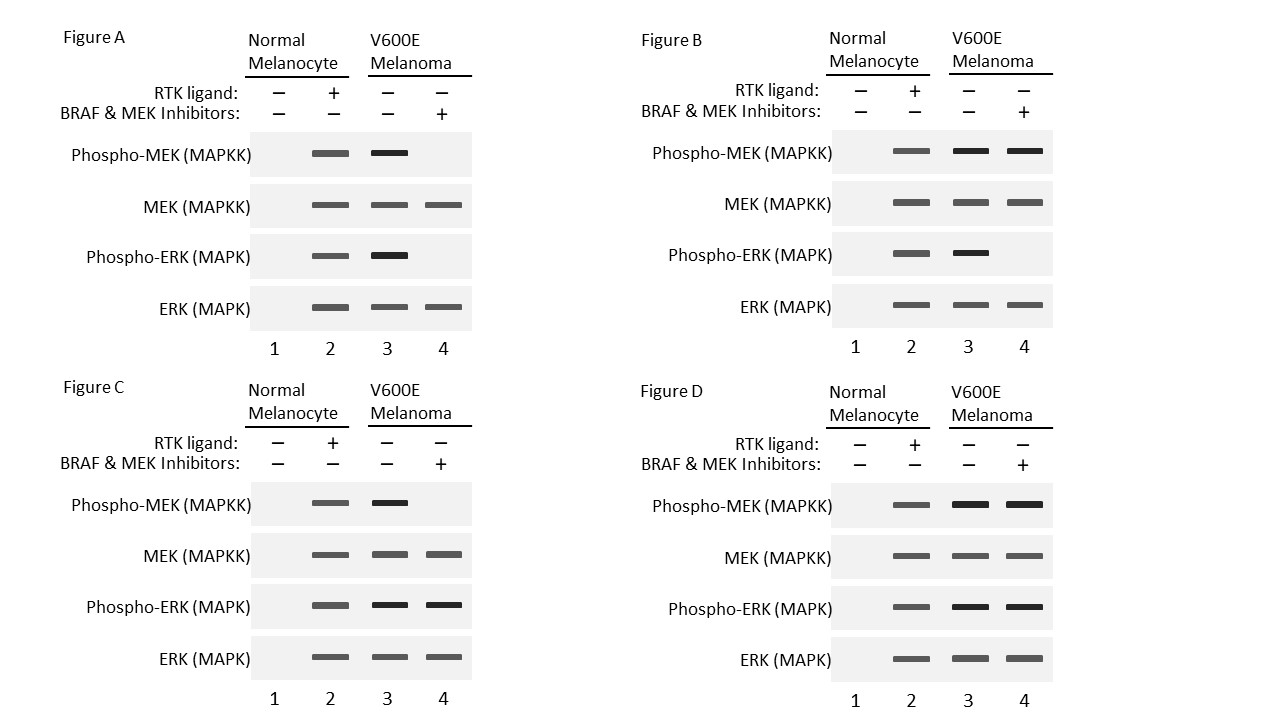
Approximately half of all melanoma cancers contain a mutation in the MAPKKK protein BRAF. Substitution of glutamic acid for valine at amino acid 600 (V600E) is the most common mutation and constitutively activates the BRAF MAPKKK protein. Tumors with this mutation are often more difficult to treat and more deadly making this the target of several new chemotherapy treatments. The following western blot (Figure 1) shows the total levels of MEK (MAPKK) and ERK (MAPK) and the levels of phosphorylated MEK and ERK in normal melanocytes (not cancerous) in the absence of signaling RTK ligand (−) and presence of signaling RTK ligand (+) and in V600E melanoma cells in the absence of signaling RTK ligand (−) (RTK is a receptor tyrosine kinase). Note the levels of phospho-MEK and phospho-ERK are increased in melanoma cancer cell lines with the BRAF V600E mutation even in the absence of signaling ligand.
Targeted chemotherapy drugs have been developed that, when used in combination, inhibit both BRAF V600E and MEK kinase domains. In other words, the drugs inhibit the ability of the V600E BRAF and MEK kinases to phosphorylate their target proteins (see Lane 4 of the following graphs). Which of the following western blots accurately shows the expected results of inhibiting BRAF V600E MAPKKK and MEK MAPKK in V600E melanoma cells?
Choose one:
A. Figure A
B. Figure B
C. Figure C
D. Figure D
A
Following the binding of an extracellular signal molecule, receptor tyrosine kinases (RTKs) do which of the following?
Choose one:
A.rearrange their multiple membrane-spanning helices in a way that enables self-phosphorylation
B.form dimers in which each polypeptide chain phosphorylates its own cytoplasmic tail
C.become internalized so that they can phosphorylate and activate various intracellular signaling proteins
D.form dimers in which each polypeptide chain cross-phosphorylates the cytoplasmic tail of its partner.
E.activate (or inactivate) the α and βγ subunits of G proteins
D
What do the phosphorylated tyrosines on activated RTKs do?
Choose one:
A.They serve as binding sites for a variety of intracellular signaling proteins.
B.They serve as binding sites for G proteins.
C.They help the receptor dimerize.
D.They activate the enzymatic activity of the RTKs.
E.They promote receptor internalization.
A
Which of the following are activated by many receptor tyrosine kinases (RTKs)?
Choose one or more:
A.phospholipase C
B.the monomeric GTP-binding protein Ras
C.trimeric GTP-binding proteins
D.the MAP-kinase signaling module
E.phosphoinositide 3-kinase
A and B and D and E
Ras is activated by a Ras-activating protein that does what?
Choose one:
A.dephosphorylates Ras
B.causes Ras to interact with a phosphorylated RTK
C.phosphorylates Ras
D.causes Ras to hydrolyze its bound GTP
E.causes Ras to exchange GDP for GTP
E
Certain mutant Ras proteins cannot hydrolyze their bound GTP to GDP, and therefore cannot do which of the following?
Choose one:
A.be degraded
B.turn themselves off
C.activate MAP kinase directly
D.turn themselves on
E.promote cell proliferation
B
Which of the following would be a plausible strategy for reducing the activity of the Ras protein?
Choose one:
A.introducing a mutation that reduces the protein’s affinity for GDP
B.introducing a mutation that enhances the protein’s affinity for GDP
C.introducing a mutation that inactivates the protein’s GTPase activity
D.inhibiting the GTPase-activating protein (GAP) that promotes GTP hydrolysis
E.introducing a non-hydrolyzable form of GTP
B
RTKs can activate the enzyme phosphoinositide 3-kinase, which phosphorylates inositol phospholipids. These phospholipids then do what?
Choose one:
A.activate Ca2+ channels in the plasma membrane, promoting an influx of Ca2+ into the cytosol
B.activate G proteins
C.serve as phosphate donors in phosphorylation reactions
D.serve as docking sites that recruit specific intracellular signaling proteins to the plasma membrane
E.activate Ras
D
The binding of a growth factor to an RTK activates the PI 3-kinase–Akt signaling pathway, which promotes both cell survival and cell growth. How does Akt stimulate cell growth?
Choose one:
A.by activating Bad, which inactivates Bcl2
B.by inactivating Tor
C.by activating Tor
D.by inactivating Bad, which activates Bcl2
E.by phosphorylating rapamycin
C
PI 3-kinase acts by phosphorylating what molecule(s)?
Choose one:
A.inositol phospholipids
B.tyrosines on protein kinases that phosphorylate Akt
C.serines or threonines on protein kinases that phosphorylate Akt
D.serines or threonines of Akt
E.tyrosines of Akt
A
Which is true of signal integration?
Choose one:
A.It might involve a kinase in one signaling pathway inactivating a kinase in another pathway.
B.It relies on positive and negative feedback amplifying and dampening a signal.
C.It requires the generation of small intracellular messenger molecules.
D.It takes place when a single, activated target protein delivers a signal to many downstream effectors.
E.It can only take place between receptors of the same class.
A
Ras can exist in two different conformations or states, inactive and active. Which of the following correctly describe(s) the stably active state of Ras?
Choose one or more:
A. Switch 1 and switch 2 regions are in an active conformation.
B. Ras is bound to GTP.
C. Ras is bound to GDP.
D. Ras is bound to Ras-GAP.
A and B
Specific amino acids, including Arg 789 in Ras-GAP and amino acids Gln 61 and Thr 35 in Ras, all play an important role in Ras function. Why are these amino acids important?
Choose one:
A. They help Ras bind GTP tightly.
B. They help downstream signaling by binding to additional signaling proteins.
C. They help facilitate GTP hydrolysis by Ras.
D. They help Ras bind GDP tightly.
C
Which is true of the Notch signaling pathway?
Choose one:
A.Notch is an intracellular receptor that travels to the nucleus where it regulates gene transcription.
B.The Notch receptor is located in the nuclear membrane.
C.The Notch receptor activates gene expression by triggering the production of cyclic AMP.
D.The tail of the cell-surface receptor travels to the nucleus where it regulates gene transcription.
E.The Notch receptor is activated by cyclic AMP.
D
Investigators studying a particular cell response are curious about what type of cell-surface receptor might trigger it. They incubate cells with EDTA, a chemical known to sequester Ca2+.
This treatment, they find, abolishes the response they are studying. Based on this information, which type of receptor is likely to be involved?
Choose one:
A.enzyme-coupled receptors
B.G-protein-coupled receptors
C.The results are not sufficient to draw any conclusions.
D. ion-channel-coupled receptors
C
How do different steroids trigger the transcription of different sets of target genes?
Choose one:
A.Each hormone binds to a different nuclear receptor, and each receptor acts at a different set of regulatory sites in DNA.
B.Each hormone binds to a different nuclear receptor, and each receptor activates a different G protein.
C.Each hormone enters the cell through a different channel protein.
D.Each hormone binds to a different nuclear receptor, which triggers the production of a different second messenger.
E.Each hormone binds to a different cell-surface receptor, and each receptor acts at a different set of regulatory sites in DNA.
A
Which of these represents a mechanism used to terminate a signal transmitted by activated RTKs?
Choose one:
A.The RTK is inactivated by phospholipase C.
B.Tyrosine kinases remove the phosphates from RTKs and other intracellular signaling proteins.
C.The RTKs are internalized and digested in lysosomes.
D.SH2 domains remove the phosphates from RTKs and other intracellular signaling proteins.
E.SH2 domains are internalized and digested in lysosomes.
C
How does the binding of a signal molecule activate an RTK for downstream signaling?
Choose one:
A. The RTK undergoes a cleavage event to release the cytosolic portion.
B. The RTK forms a dimer and cross-phosphorylates itself.
C. The RTK changes conformation to stimulate a G-protein.
D. The RTK is an ion channel that opens in response to ligand binding.
B
If Ras contains a mutation that leads to a defect in GTP hydrolysis, this could fuel uncontrolled proliferation in cancer because
Choose one:
A.Ras is able to signal to downstream pathways inappropriately.
B.Ras is able to migrate to the nucleus and deactivate transcription of proliferation genes.
C.Ras is unable to bind to the GEF for activation.
D.Ras is unable to send signals to downstream pathways.
A
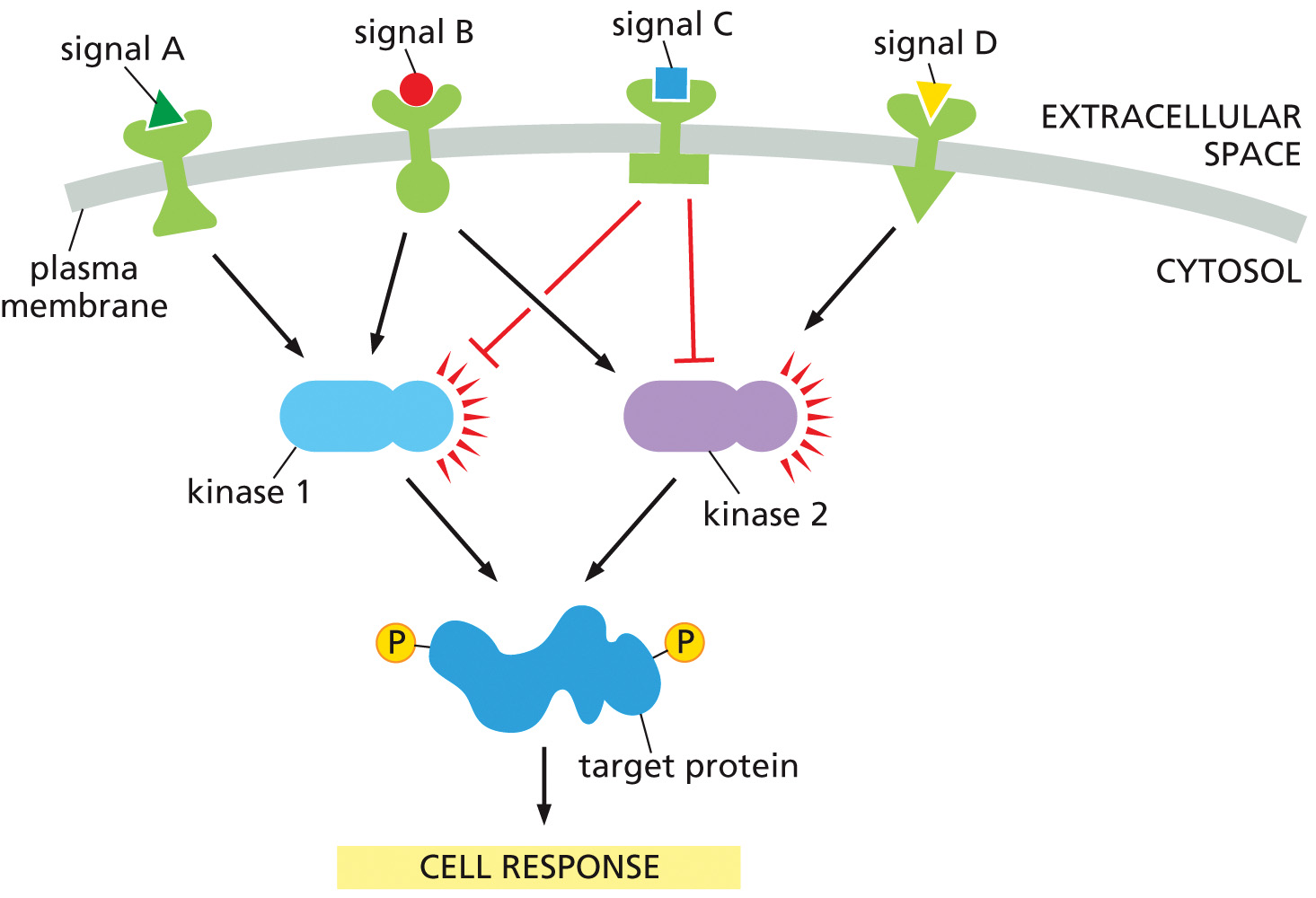
Shown is a diagram of how theoretical intracellular signaling pathways could integrate incoming signals to produce a coordinated cell response.
Which signal(s) would lead to activation of both kinase 1 and kinase 2?
Choose one:
A.signal C
B.signals A and D
C.signals A and C
D.signals C and D
B
Steroid hormones trigger transcription of target genes by
Choose one:
A.binding directly to DNA and stimulating transcription.
B.activating a kinase cascade that results in the activation of a transcription factor for a set of genes.
C.activating the release of Ca+2 ions that bind to and activate transcription factors.
D.binding to nuclear receptors that act as transcription factors for specific genes.
D
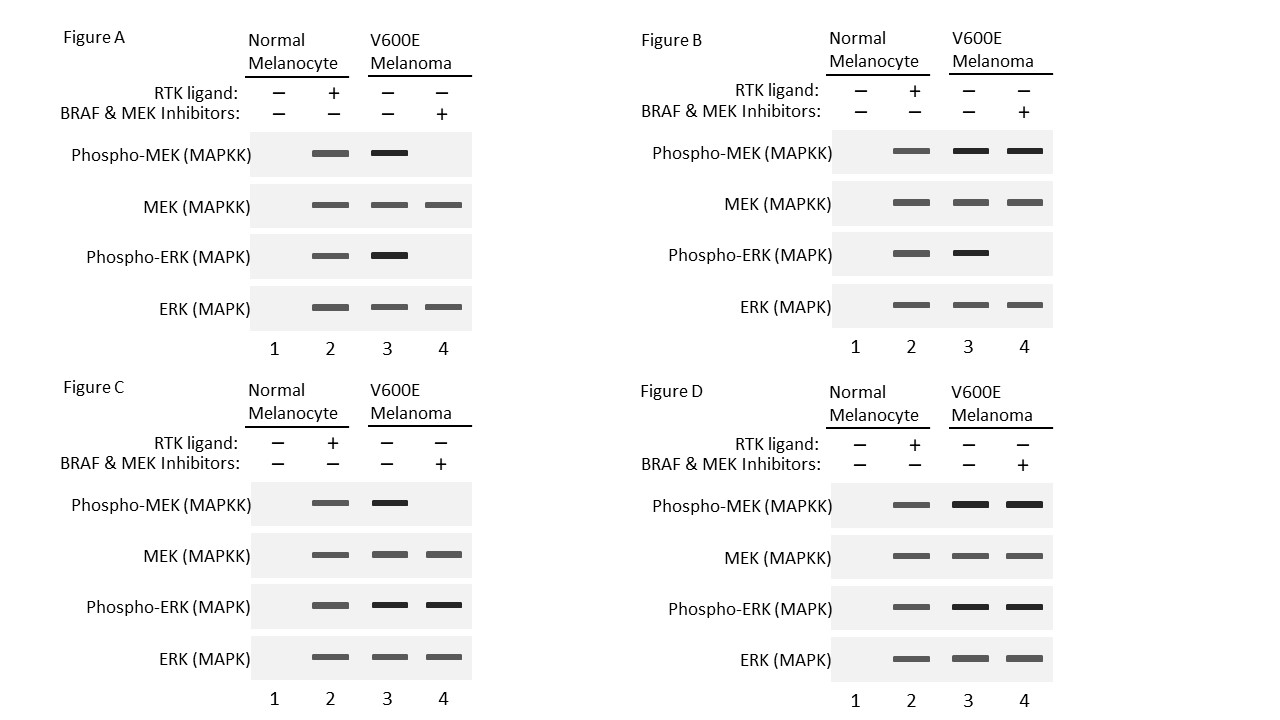
Approximately half of all melanoma cancers contain a mutation in the MAPKKK protein BRAF. Substitution of glutamic acid for valine at amino acid 600 (V600E) is the most common mutation and constitutively activates the BRAF MAPKKK protein. Tumors with this mutation are often more difficult to treat and more deadly making this the target of several new chemotherapy treatments. The following western blot (Figure 1) shows the total levels of MEK (MAPKK) and ERK (MAPK) and the levels of phosphorylated MEK and ERK in normal melanocytes (not cancerous) in the absence of signaling RTK ligand (−) and presence of signaling RTK ligand (+) and in V600E melanoma cells in the absence of signaling RTK ligand (−) (RTK is a receptor tyrosine kinase). Note the levels of phospho-MEK and phospho-ERK are increased in melanoma cancer cell lines with the BRAF V600E mutation even in the absence of signaling ligand.
Targeted chemotherapy drugs have been developed that, when used in combination, inhibit both BRAF V600E and MEK kinase domains. In other words, the drugs inhibit the ability of the V600E BRAF and MEK kinases to phosphorylate their target proteins (see Lane 4 of the following graphs). Which of the following western blots accurately shows the expected results of inhibiting BRAF V600E MAPKKK and MEK MAPKK in V600E melanoma cells?
Choose one:
A. Figure A
B. Figure B
C. Figure C
D. Figure D
A
Which of the following statements are consistent with the structure and function of intermediate filaments?
Choose one or more:
A. Intermediate filaments protect cells from mechanical stress because they have high tensile strength and resist stretching.
B. Each filament is made of eight strands, and each strand is made from staggered tetramers linked end to end.
C. Intermediate filaments can connect cells at cell–cell junctions called desmosomes.
D. Intermediate filaments are constructed of identical subunits found in all eukaryotic cells.
A and B and C
Mutation of the muscle-specific intermediate filament desmin leads to the rare disease desmin-related myopathy. This disorder starts with weakness of the lower limbs when patients are in their 20s or 30s. As symptoms worsen, weakness in respiratory and cardiac muscles occurs, which can lead to serious problems including sudden cardiac arrest.
Which of the following mutations would disrupt desmin intermediate filament structure or function and could explain the symptoms of desmin-related myopathy? Choose all of the possible mutations.
Choose one or more:
A. Disruption of the polarity of the final desmin strands.
B. Alteration in the twist or coiling of the dimers, blocking formation of staggered tetramers.
C. Mutation such that formation of dimers is blocked.
D. Alteration in head groups, so tetramers are unable to link end to end.
B and C and D
Which of the following would be a consequence of mutations that disrupt the interaction between cross-linking, stabilizing proteins and keratin filaments?
Choose one:
A. defects in muscle development caused by improper organization of sarcomeres
B. skeletal and cardiac abnormalities caused by a weakened nuclear envelope
C. corneal damage caused by cell rupture from mechanical trauma
D. developmental defects caused by abnormal assembly of cilia
E. neurodegeneration caused by an interference with normal axonal transport
C
Nocodazole is a microtubule-specific drug that binds free tubulin dimers and blocks microtubule polymerization. Adding nocodazole to cells causes multiple effects. Which of the following would occur after nocodazole is added to cells growing in culture?
Choose one or more:
A. The cell cycle arrests in mitosis.
B. The nucleus has structural problems.
C. The Golgi apparatus fails to organize at the normal site near the nucleus.
D. Muscle cells show decreased muscle contraction.
A and C

Recombinant tubulin can be synthesized and purified. When incubated in the right conditions, the tubulin dimers will assemble and form microtubules in vitro. Microtubules formed from wild-type tubulin show dynamic instability, as expected. Tubulin with an E254A (glutamate 254 to alanine) mutation has a normal structure but fails to hydrolyze GTP in the tubulin dimer. The following graphs show the length of 5 microtubules over time. Which of the graphs accurately portrays the length of microtubules assembled with the mutant E254A tubulin?
Choose one:
A. Graph A
B. Graph B
C. Graph C
D. Graph D
C

Recombinant tubulin can be synthesized and purified. When incubated in the right conditions, the tubulin dimers will assemble and form microtubules in vitro. Microtubules formed from wild-type tubulin show dynamic instability, as expected. Tubulin with an E254A (glutamate 254 to alanine) mutation has a normal structure but fails to hydrolyze GTP in the tubulin dimer. The following graphs show the length of 5 microtubules over time. End-binding proteins are found bound to the GTP tubulin in the GTP cap of microtubules. Where would the end-binding protein EB3 be found if added to the microtubules assembled from the E254A mutant tubulin?
Choose one:
A. Only at the plus end of the microtubules
B. Only at the minus end of the microtubules
C. All along the microtubules
D. EB3 would not bind the mutant microtubules
C
GTP hydrolysis and whether GTP or GDP is bound to tubulin is an important mechanism to control the dynamic instability of microtubules. Certain aspects of dynamic instability can be viewed using GFP-EB1. Which process(es) is it useful for visualizing and why?
Choose one:
A. growing and shrinking microtubules, because EB1 binds to the GDP-tubulin cap on microtubules
B. growing and shrinking microtubules, because EB1 binds to the GTP-tubulin cap on microtubules
C. growing microtubules, because EB1 binds to the GTP-tubulin cap on microtubules
D. shrinking microtubules, because EB1 binds to the GTP-tubulin cap on microtubules
C
How would the animation of microtubule dynamics change after adding a non-hydrolyzable analog of GTP to the cells expressing GFP tubulin?
Choose one:
A. Dynamic instability would increase as microtubules rapidly switch between growing and shrinking.
B. Microtubule dynamics would not change.
C. Microtubules would shrink.
D. Microtubules would grow longer.
D
Which statement about intermediate filaments is not true?
Choose one:
A. They are wider than actin filaments.
B. Their disruption can lead to premature aging.
C. They lack polarity.
D. They rupture under stress.
E. They have the highest tensile strength of all the cytoskeletal filaments.
D
If GTP hydrolysis occurs on a tubulin molecule at the plus end of a microtubule protofilament before another tubulin molecule is added, what typically happens?
Choose one:
A. The microtubule remains the same size.
B. The GDP is rapidly exchanged for a fresh molecule of GTP.
C. The microtubule depolymerizes.
D. The microtubule polymerizes.
C
The energy in ATP is used to fuel the movement of kinesin motor proteins along microtubules. Sort each of the following events into the proper category, indicating whether they occur on the leading or trailing head of kinesin.
categories: leading head, trailing head
items: ADP release, ATP binding, ATP hydrolysis, Pi release, Neck linker zippers to catalytic core of head group
leading head: ADP release, ATP binding, Neck linker zippers to catalytic core of head group
trailing head: ATP hydrolysis, Pi release
An experiment was performed to determine the role that ATP plays in kinesin movement along microtubules. Kinesin and microtubules were incubated together in a test tube, but instead of ATP, a non-hydrolyzable analog of ATP was added to the tube. What impact on kinesin function do you expect to observe in the presence of this ATP analog?
Choose one:
A. The leading head would bind tightly, but the trailing head would remain free.
B. The kinesin would be unable to bind to microtubules since the kinesin would remain inactive.
C. The kinesin would bind tightly to microtubules and not release.
D. The kinesin would walk faster along the microtubule since the kinesin would remain active while bound to ATP.
C
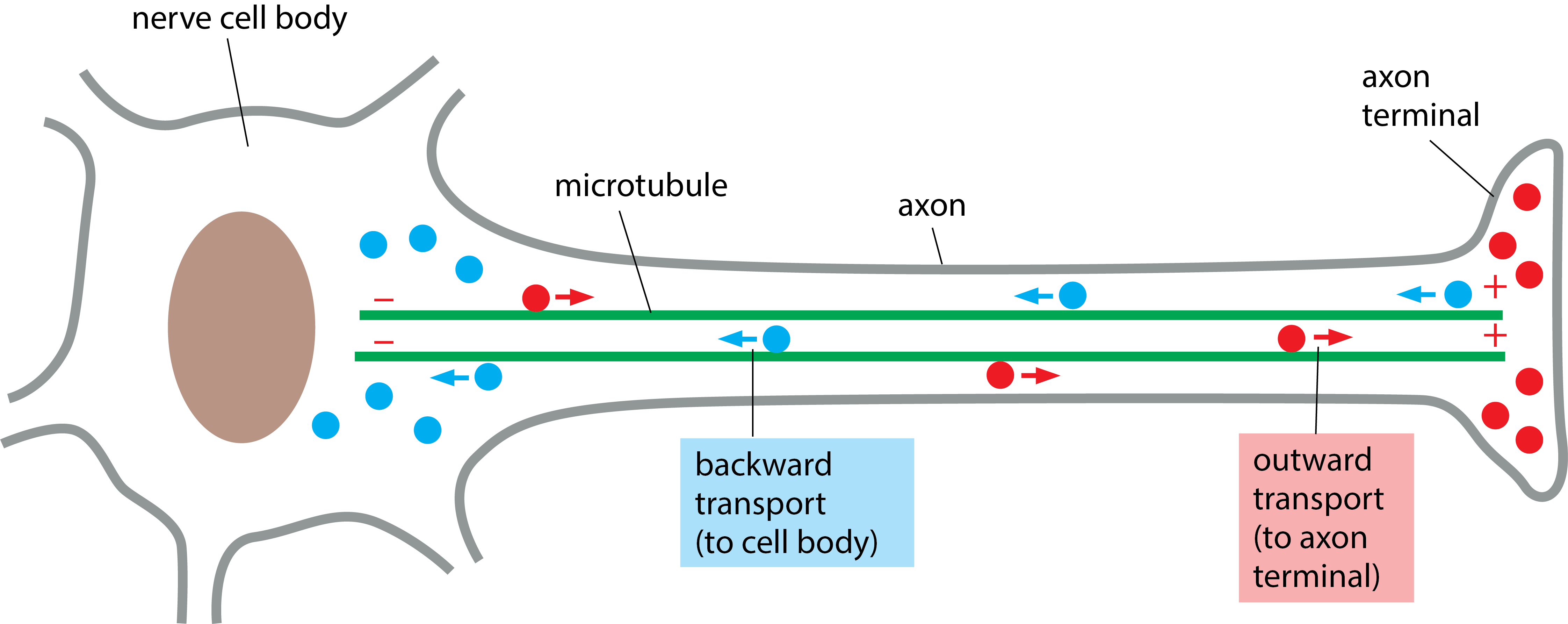
Motor neuron degeneration occurs in several diseases and leads to loss of muscle control. One form of motor neuron degeneration was found to have defects in retrograde transport (backward transport to cell body, in blue below) that were caused by mutations in a gene that codes for a particular protein.
What protein, when mutated, would inhibit backward, but not outward, transport along axon microtubules?
Choose one:
A. tubulin
B. myosin
C. kinesin
D. dynein
D
The single-celled green algae Chlamydomonas reinhardtii has two flagella the cells use to move through their environment. The structure and function of eukaryotic flagella have been extensively studied by using C. reinhardtii as a model system. C. reinhardtii are easily deflagellated in low pH and the cells can regenerate their flagella once pH is returned to normal. The intraflagellar transport machinery is used to move flagella components to the end of the growing flagellum. Which of the following proteins is responsible for moving flagellar components to the end of the growing flagellum?
Choose one:
A. Radial spoke
B. Kinesin
C. Dynein
D. Double microtubule
B
Kinesin and dynein motor proteins each use the energy of ___ to power their movements in ____ direction(s) along microtubules.
ATP, a single
As a cell grows, which microtubule-associated protein pulls the ER membrane outward, stretching it like a net?
Choose one:
A. actin
B. kinesin
C. dynein
D. cohesin
B
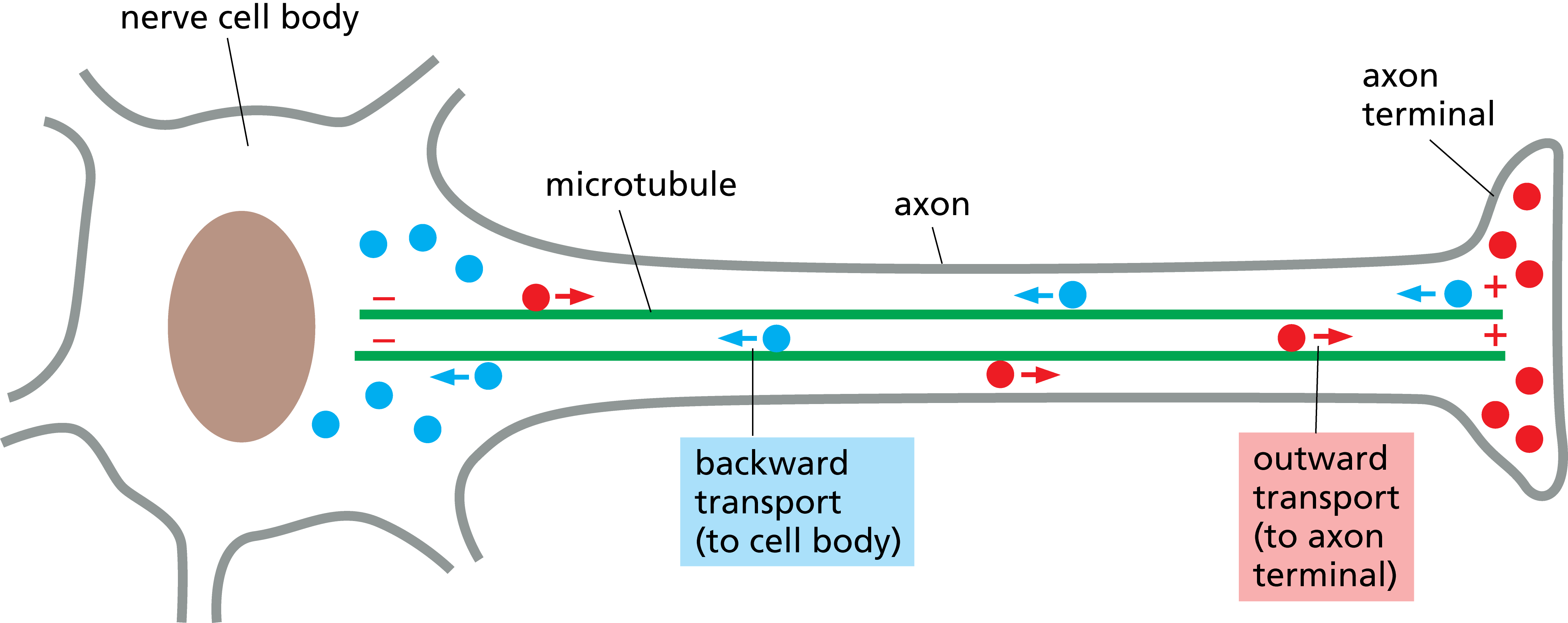
Within this image, the ___ cargo is being transported by kinesin and the ____ cargo is being transported by dynein.
red, blue
In the eukaryotic flagellum, what drives the bending of microtubules?
Choose one:
A.the motor protein ciliary dynein
B.the basal body
C.the fluid that surrounds the flagellum
D.ciliary actin and myosin
A
What does the cellular motility of sperm depend on?
Choose one:
A.microtubules and kinesin
B.actin and kinesin
C.actin and myosin
D.microtubules and dynein
D
An actin-binding protein called cofilin binds preferentially to ADP-containing actin filaments rather than ATP-containing actin filaments. Based on this preference, which is true?
Choose one:
A. Cofilin binds to older actin filaments.
B. Cofilin competes with profilin for binding to actin.
C. Cofilin binds to the plus ends of treadmilling actin filaments.
D. Cofilin binds to the plus ends of actin filaments.
A